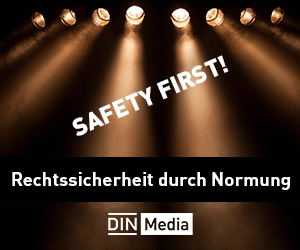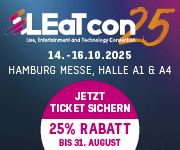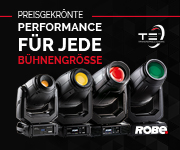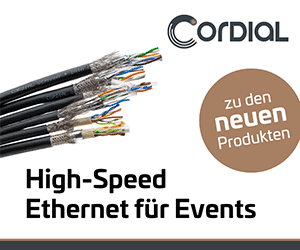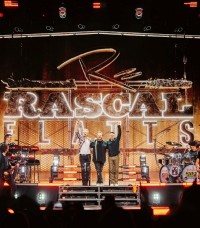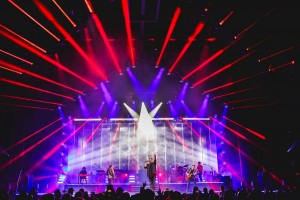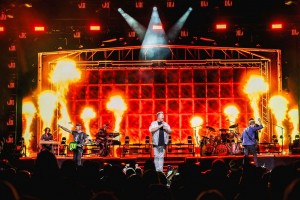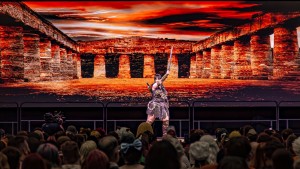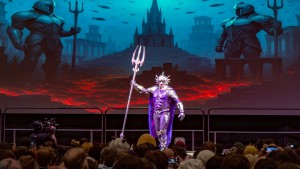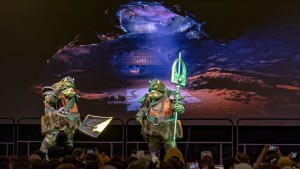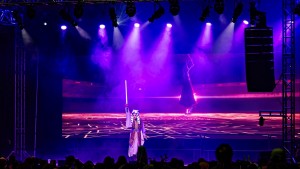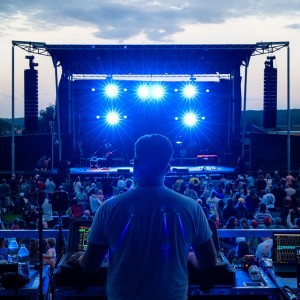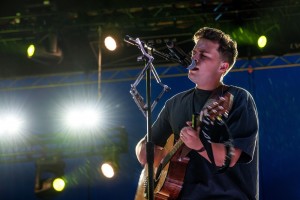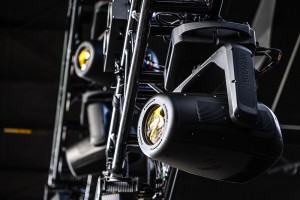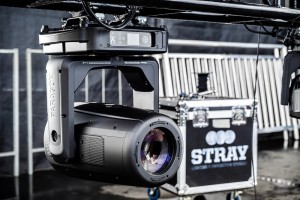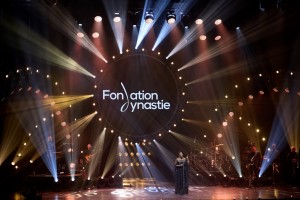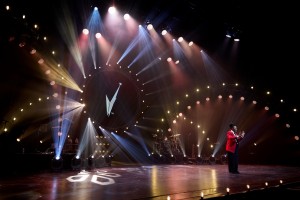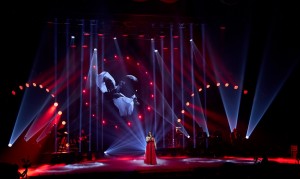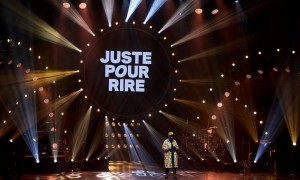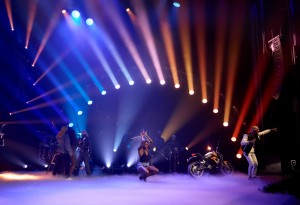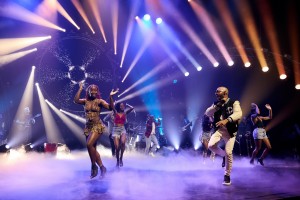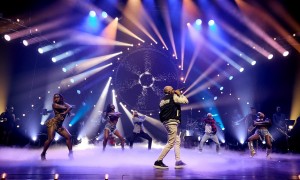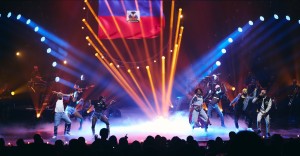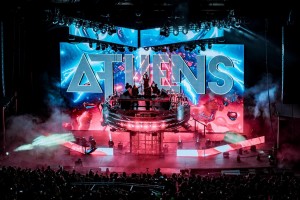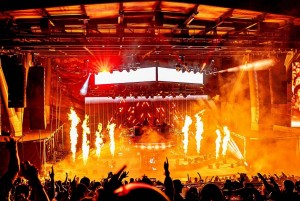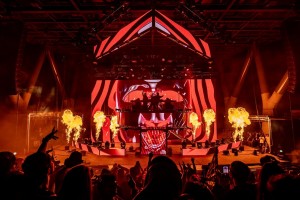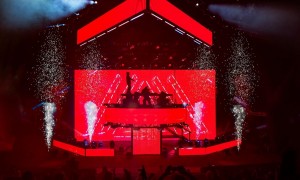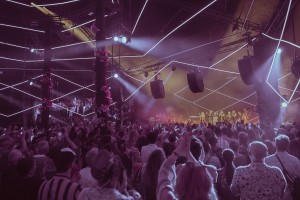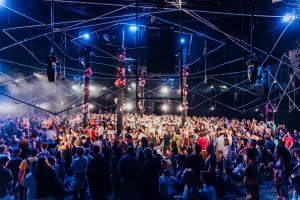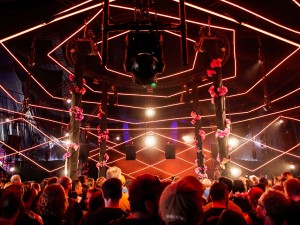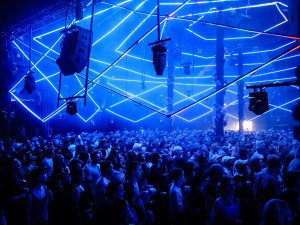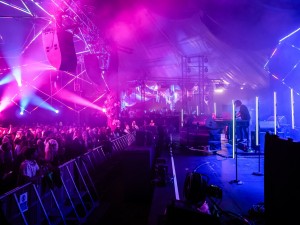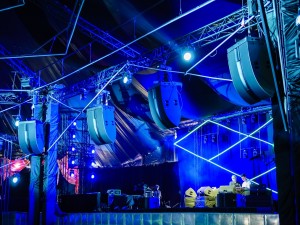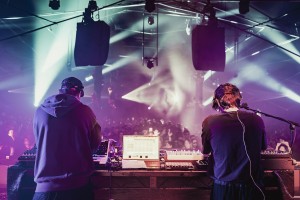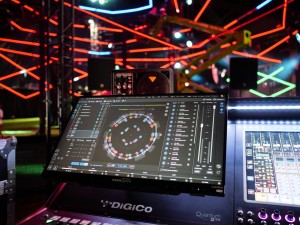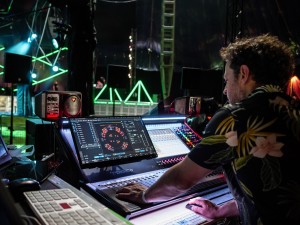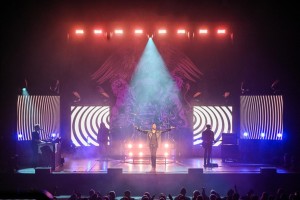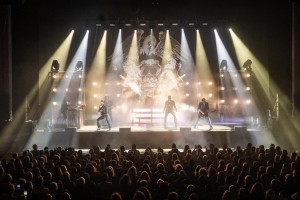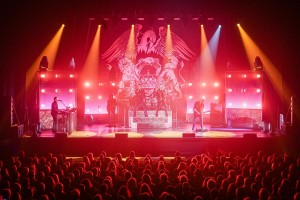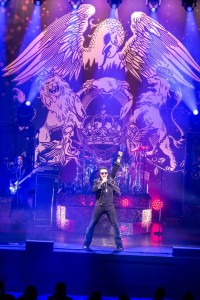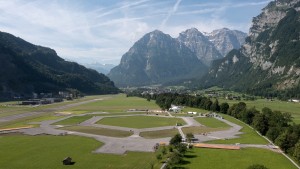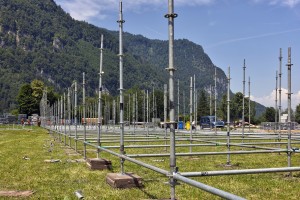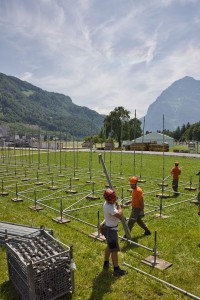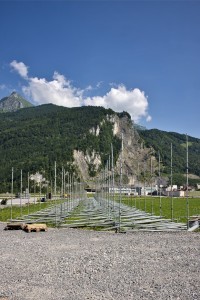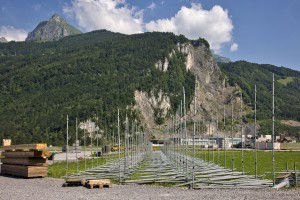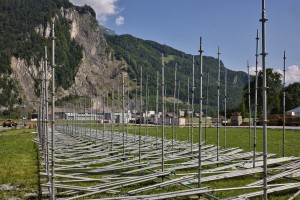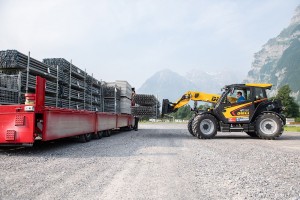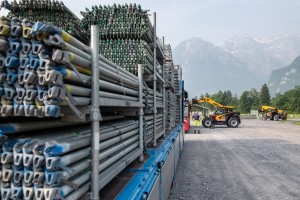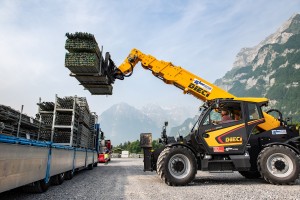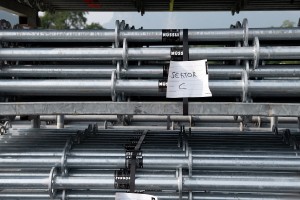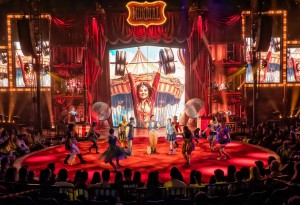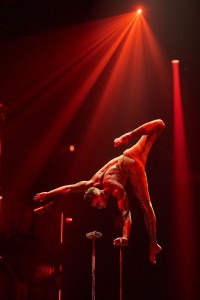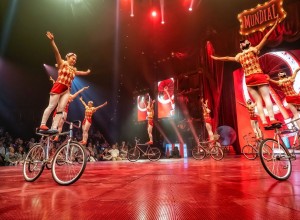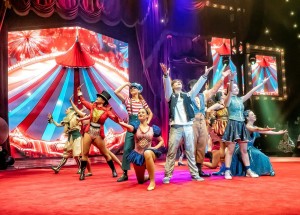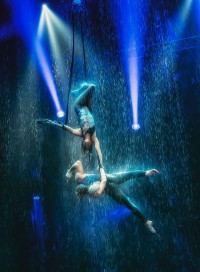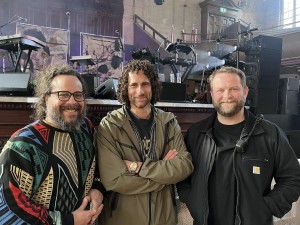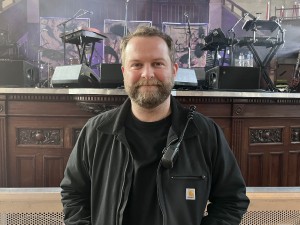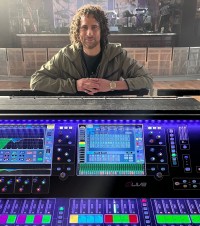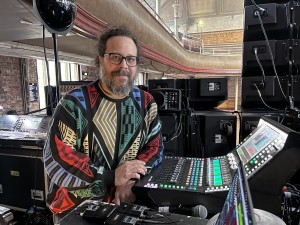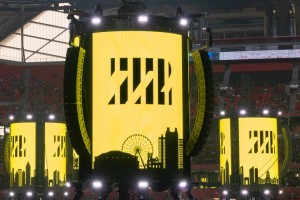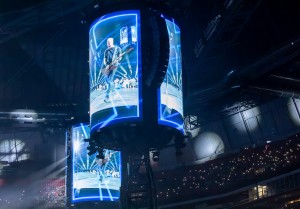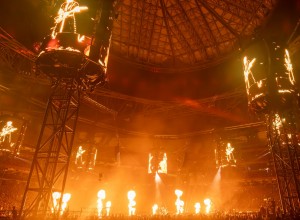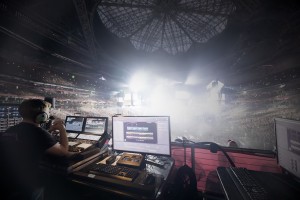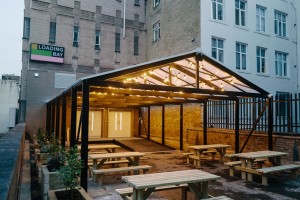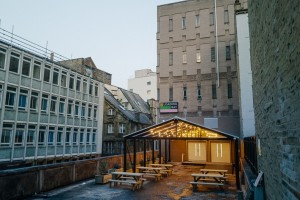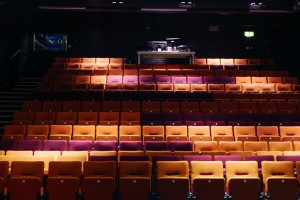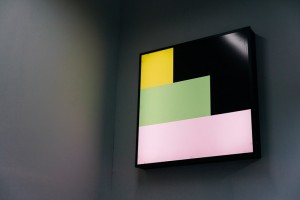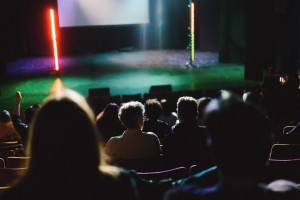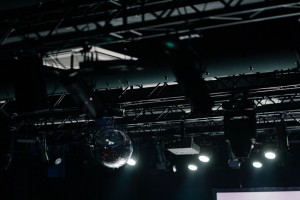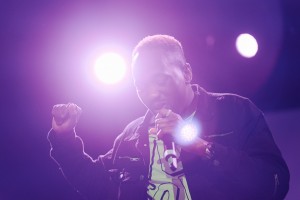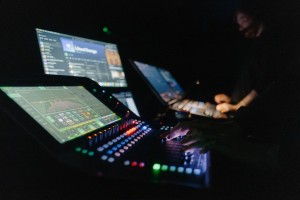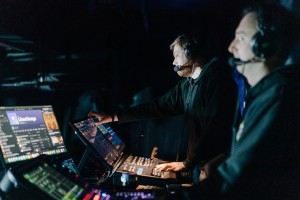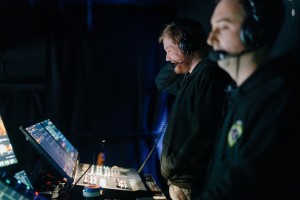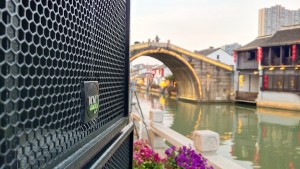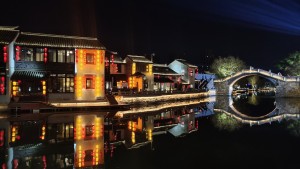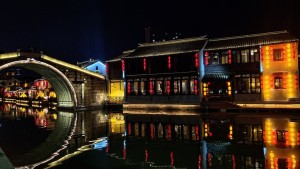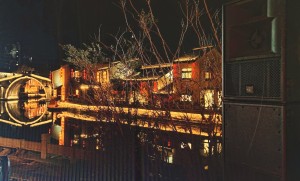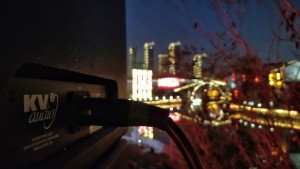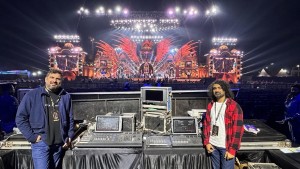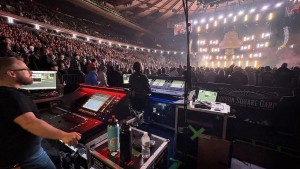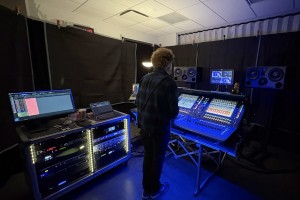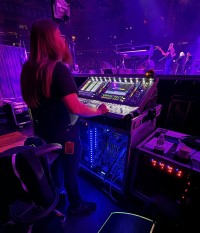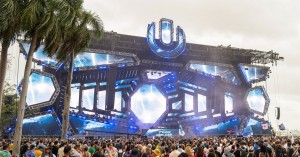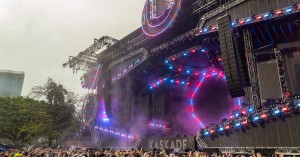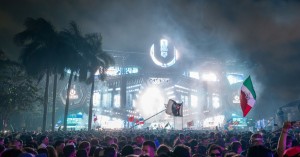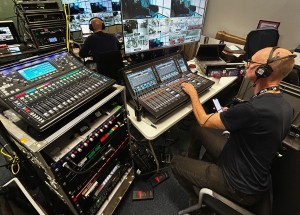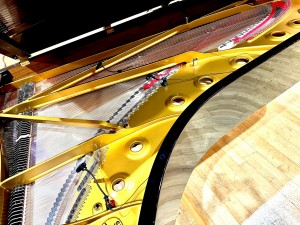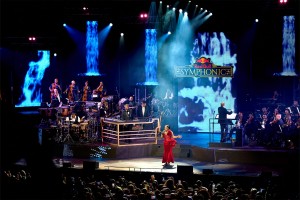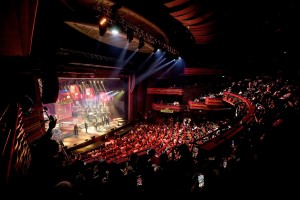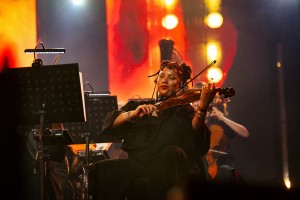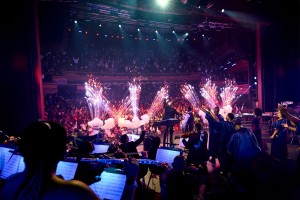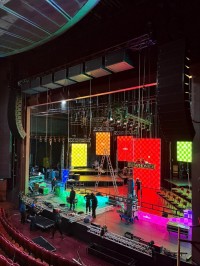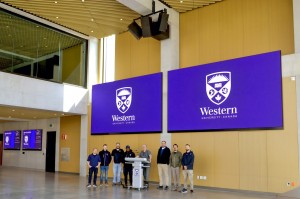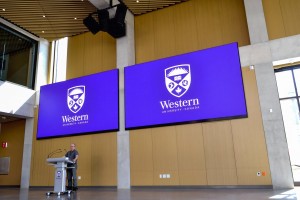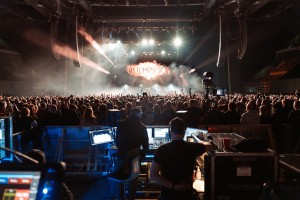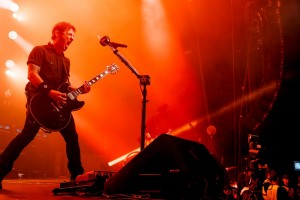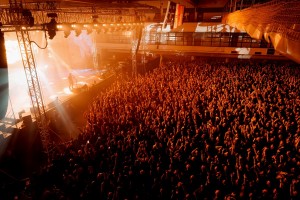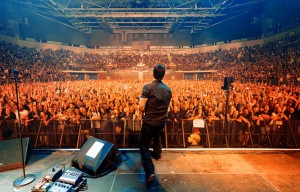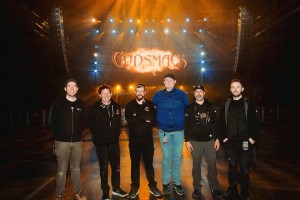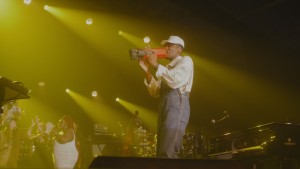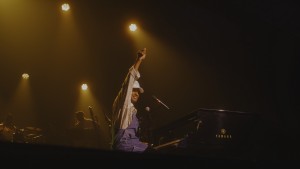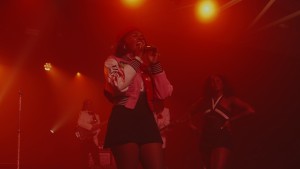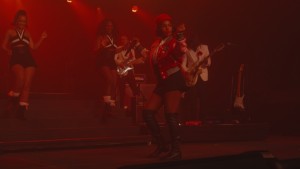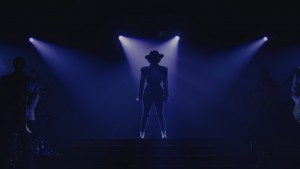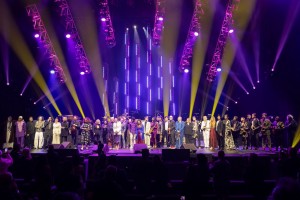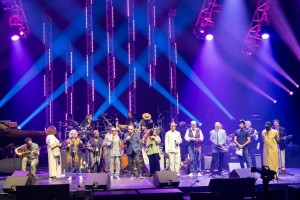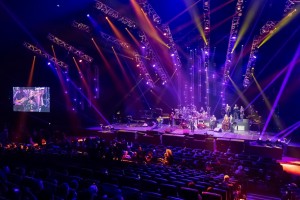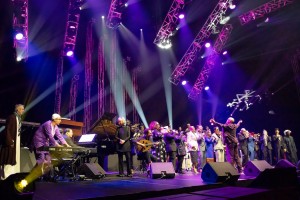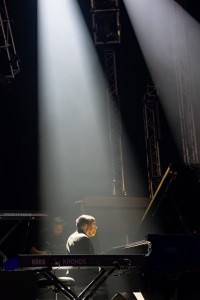Rental News
Rental News Schlagzeilen
Clair Global supports Teddy Swims tour
30/06/2025
Jason Hyne powers Queen Extravaganza’s “Bohemian Rhapsody” 50th anniversary celebration with ChamSys
25/06/2025
Lüz Studio lights Rascal Flatts tour with Chauvet
Matthieu Larivée and the team at Lüz Studio created the production design for Rascal Flatts’ 21-city “Life Is A Highway Tour”, which ran for three months this year in North America. The tour covered the band’s 25-year career, one that has resulted in sixteen No. 1 hits and over 11 million concert tickets sold. When discussing the best ways to reflect the band’s achievements, the Lüz team took a slight step back from the immersive 3D video elements that characterize many of their designs and leaned more heavily on light.
“Given the nature of this retrospective tour and the band’s rich history, we focused on lighting, which is timeless”, says Larivée. “Their catalog has some ballads, which needs gobos or very subtle lighting chases; power ballads, which needs powerful lighting swaps; and rock’n’roll songs, which needs dynamic FX. Therefore, our lighting rig, mixed with the digital lighting rig, gave all the tools to support the show.”
A key part of the show’s non-digital lighting rig were its forty-two Chauvet Professional Maverick Storm 1 Hybrid fixtures supplied by Bandit Lites. Larivée used the 420 W, 7700 K source beam-spot-wash units to set a wide range of moods with colors and gobos. “We had the Storm 1 Hybrid in various positions to aid us in defining the shape of the rig without being too graphic and modern”, he says. “Also, since this tour was a celebration of the client’s 25th years of music, we wanted to support a strong connection to the audience, so we used two V trusses to help bridge the stage with the audience light.”
Light, digital light and video were blended in this production to create an engaging canvas for the band to tell its story through music. “We did use one set extension for the entire show with multiple layers. Like a Swiss army knife”, notes Larivée. “The condense video was dynamic, but it displayed a 90-minute show within thirty seconds.”
“We started the show with the band logo on a 3D sign and we did light it up differently for three songs”, he continues. “That way we were able to focus on the band for top of show. Then we flew the sign to get to a virtual canvas for IMAG. That canvas was a frosted glass. Behind this glass was a wall of light that came in slowly though the next couple of songs, until at one point we got to the wall of lights and stayed there until the end of the show. So, the idea is really about having a digital lighting rig to enhance the actual lighting rig, and less about a set extension or location.”
Helping to ensure that the light rig had the flexibility to flow with the digital and video element of the design was a floor cart system created by Bandit’s Dizzy Gosnell, Jake Tickle, and Andy Knighton. “With the two faces, they could light up and then create unique graphical effects that never felt too repetitive”, says Larivée of the carts, adding that “they helped light serves as a bridge between the band and video screen“.
(Photos: Grayson Gregory)
John Garberson and Creative BackStage celebrate Phoenix Fan Fusion with Chauvet
A record-setting crowd of over 130,000 fans filled the Phoenix Convention Center during the three-day Phoenix Fan Fusion event. John Garberson and his 30-person team at Creative BackStage set up the lighting, sound, and video for two general session rooms and thirty breakout rooms.
“Set-up took three days, but we were able to strike the event in five hours, thanks to our awesome team, which included Matthew Breg, L1/board op; Tyler Coan, L2; Michael Morse, L2; and Maxine Kichler, rigging”, says Garberson. “There was a lot of coordination involved in doing this quickly and efficiently.”
In keeping with this mission, Garberson took steps to save time throughout the set-up process. For example, he decided it was cheaper and faster to bring in a self-climbing roof system, rather than fly the production for the big rooms. The roof added depth to the stage and created “that black box stage feel”, as he puts it.
Enhancing the mood on the general session rooms stages and throughout the breakout rooms was a collection of Chauvet Professional fixtures from Creative BackStage’s own inventory. Garberson used his fixtures differently at different times throughout the event.
“We had twenty Rogue R2 Washes in the main general session room”, he details. “Half of these fixtures were in the front by the stage, eight were in the back of the room and the other two on the sides. We washed the walls in mood-setting colors, mostly shades of red, with the Rogues during the day. At night we used them for more dynamic looks to animate parties, drag shows and various contests.”
Maverick MK2 Spots from Chauvet Professional also played a big role in helping the Creative BackStage team conjure up a wide variety of looks for the imaginative mix of out-of-the-ordinary productions that enlivened this very special event. During the day, the 440 W moving fixture was used for gobo breakups on the walls and ceiling. When night came, the MK2 Spots cut loose, animating the stage for a wide array of looks. “They fit this project perfectly”, says Garberson. “We got a nice balance from them that included gobo projections, IMAG lighting and lighting the characters on stage.”
(Photos: Chauvet Professional)
Stray Production Services turns to Elation Paragon for “WJTL Fest”
Christian radio station WJTL returned to Cherry Crest Adventure Farm near Lancaster, Pennsylvania, on May 17, 2025, for “WJTL Fest” - a day filled with music, fun activities, and uplifting moments. Stray Production Services brought its new Paragon LED profile luminaires from Elation for the event, with Stray’s Jon Boyer handling the lighting design.
“Because the event is outside on a mobile stage, during the day, and without haze, I needed a fixture punchy enough to make an impact but also diverse enough that I could create an artistic show”, says Boyer. “It proved an ideal event for our new Paragon fixtures.” As Stray’s outdoor event roster continues to grow, the company invested in the Paragon M earlier this spring, choosing it as the new workhorse fixture for indoor and outdoor productions.
“Something we ran into a lot the past couple of years is trying to fit all the lights designers want on a mobile stage”, says Mark Bartlett, VP of Events at Stray. “Our Paragons are brighter, lighter and more compact than our 1000 W discharge fixtures and that weight savings is critical when working with the truss limitations of portable stages.”
The Paragon’s IP54 weatherproof rating offers protection against water and dust ingress, and also allows for a more compact, lightweight design. On “WJTL Fest”, six Paragon M fixtures were used as the main profile fixture on two separate upstage trusses. The Paragon M emits over 37,000 lumens, which proved essential on the event since most of the performances took place during daylight hours.
“One of my favorite looks was having the fixtures sweep from the stage up over the audience, then on the hit, all the lights strobed, quickly dropped back to the deck, changed color, and went into a pointed intensity chase”, says Boyer. “It was a great effect, and I look forward to using them in the future to create even bigger and better shows.”
(Photos: Tom Roe)
Clair Global supports Teddy Swims tour
American singer-songwriter Teddy Swims has blended country, pop, and R&B into a global success story, accompanied this year by his biggest live shows to date, including a sold-out arena run in the UK, setting a new attendance record at Manchester’s Co-op Live venue. The “I’ve Tried Everything But Therapy” tour is now in the US before the team returns to Australia this autumn, followed by Asia and the Middle East.
“My history is mixing pop elements, attuned to mixing like a record, whereas Teddy’s tour is a nice hybrid”, says Swims’ FOH Mixer Drew Thornton (Billie Eilish, Maggie Rogers). “This is a unique camp where they use a lot of my board feeds for Teddy’s social media. I’ll add a little bit of ambience and then sidechain it to timecode, so it dips it when the song’s happening. I’m basically building a broadcast mix.”
Thornton is riding the faders on an Allen & Heath dLive S5000, and he is also utilizing two 10th generation Waves Extreme SoundGrid Servers. “There’s a lot of options with Waves, such as the SuperRack LiveBox VST3 plugins”, he says. “Our Production Manager Rob Bright really cares about audio, and us being comfortable, which is very important when you’re touring a show like this. Equipment-wise, I have everything I need from Clair Global. I’ve gotten to work with Justin Weaver on the last couple of tours I’ve done, and he’s fantastic, but this is the first time I’ve worked with Ben Shapiro, who has been working alongside Justin, and he’s also incredibly responsive.”
Outside of the crew, Thornton also praises the man himself: “Teddy doesn’t take himself too seriously and has a great sense of humor. He’s such a wonderful person to work with. He makes this gig 100% worth it because he really cares about every single person on his tour. When we were rehearsing at Rock Lititz, he wanted to learn every one of the 60+ crew members’ names!”
When it comes to choosing PA for Swims’ live renditions, Thornton declares he’s trying “something different”: “It was a very deliberate decision to go with the d&b KSL because of the cardioid factor. I think of it as wasted energy when you have omnidirectional, low-end drivers firing everywhere into the room. To me, there’s so many things happening in this show - a lot of people on stage needing attention - and I want everyone to sound big across the whole room.”
“I geolocate every single post that I do, and then cross reference social media stories from the audience in various parts of the arena as a way for me to walk the room when I can’t”, he continues. “It’s interesting to see how great it can sound in the back corners, the toughest parts of any room to cover, but my Systems Engineer Jack Murphy is constantly making me happy; we want to make sure that we give everyone a great show, every time.”
“I didn’t really know what to expect coming into this gig”, says Murphy. “It’s big and full and Drew wants to make an impact, getting Teddy’s massive vocal heard in every seat. It’s the same for me; everybody in that arena has bought a ticket, and spent money to see the show, so it needs to sound as good as it possibly can.”
Main hangs are a mixture of KSL8s and KSL12s, and KSL side hangs. A decision to fly SL-Subs came as audience demand grew in the UK, and the audio team then opened the rig to 270-degrees, adding a rear hang of d&b V Series. Ground subs are more SL-Subs & Y10Ps for front fills.
Murphy continues: “As Drew was new to the system, I went back to the start and together we listened through the different configuration combinations to find the one that suited Teddy’s sound and that Drew liked best. This allows us to achieve consistency but we’re doing very little EQ to the system as we’re using all the d&b tuning tools to get it clean and accurate from the start.”
Murphy is also the tour’s Audio Crew Chief. PA Techs on the European leg were Callum Robinson and Megan Clements. In monitor world and by special request after the tour visited Australia, Monitor Tech Lara Smith was drafted in from the JPJ Audio offices in Sydney to support Swims’ Monitor Engineer, Justin Walker.
Now Swims’ RF guru and Walker’s right-hand woman, Smith sets up the busy stage and has been getting to grips with the new Shure Axient Digital PSM IEM system. Powered by Shure WMAS Technology, she describes the product as “a game changer in digital transmission”. “We were one of the first tours in the world to take out the new system and it’s been fantastic”, she notes.
Clair has also provided wireless comms comprising Riedel Communications Bolero and Motorola XPR3500 2-way radios systems. Walker is mixing for nine people on stage, plus several tech mixes. “I just love the psychology behind mixing artists and seeing what they’re going through”, he states. “I try to be the best ears that I can for them.”
Walker has opted for a DiGiCo Quantum 338 Pulse upgrade: “I wanted to make sure that I have enough inputs and outputs for everybody. I was on an SD12 on our last tour, but as we’ve added three background vocalists and a couple more inputs, I need more internally to handle that. The Quantum processing has been great because I use Waves for additional processing, but they’re a very natural sounding band, so I don’t tweak a lot.” The band all use the new Shure Axient PSMs, and drummer Deandre Hemby has a Porter & Davies Thumper tactile monitoring system in his seat.
For Walker, vendor support has also been critical to the success of this lengthy tour. “We have a B rig, and at one point last year, we had a B and a C rig in three different parts of the world”, he concludes. “From the people in the Clair shops that put these rigs together and check everything is working as it should be, to our account reps who are always on call, it’s been a very helpful experience for me.”
Claypaky fixtures help celebrate Montreal’s “Gala Dynastie 2025”
Claypaky lighting, including Arolla Profile HPs, A.leda B-Eye K20s and Mini-Bs, comprised the bulk of the fixtures illuminating “Gala Dynastie 2025” at Montreal, Canada’s Théâtre Maisonneuve at Place des Arts. Omnison in Montreal supplied the luminaires to lighting designer Steve Wary of SW Design Lumière for the televised awards ceremony, which celebrated Black excellence across Quebec’s arts, media and cultural sectors.
“‘Gala Dynastie’ has been held every year for the past nine years, and the production has grown and the resources have evolved over that time”, notes Wary. “The creative aspect is very important to this event. Beyond the more conventional moments of an awards ceremony, there is always a big introductory show interspersed with several performances by artists. A live band is also present on stage throughout the evening.”
This year’s gala marked Wary’s first time as the show’s lighting and production designer. “I was asked to create a highly visual design that could be relevant for broadcast”, he explains. “In previous years, a big part of the show relied on LED screens that covered a large portion of the stage backdrop. My idea was to add more depth and texture by minimizing the screens - without forgetting them - and focusing more on lighting.”
“Most of the performances were intense and emotional moments, which, for me, required a creative approach to showcase them”, he adds. “I quickly felt the need to create a cozy and warm overall atmosphere in which the artist, the audience and the viewer could feel at ease.” To deliver that ambiance Wary made extensive use of rounded shapes in the overall layout, especially in the stage backdrop: “For me, they were a nice change from the usual linear shapes that are much more commonly used, but which can quickly become very modern, very straight and very cold.”
Wary’s production design featured intertwined hoop pieces that captured the depth of the main stage of the Place des Arts theater. At the center of the stage was an elevated 5-meter diameter hoop with an LED screen inside to display the nominated artists’ presentation videos as well as motion design. He placed beams and tungsten blinders around the hoop to add warmth.
Beneath the hoop was the central entrance for the artists featuring a wall of ACL lights in the background, something Wary finds “is always effective, especially when you add heavy smoke to the floor as each artist passes through this central corridor”. Two quarter hoops, each 8 meters in diameter, were placed on the floor, with two half hoops, each 12 meters in diameter, arranged between the back of the stage and the front of the stage, tying together the entire design around the central artist. He added fixtures on booms at the back and two booms at the front. On the floor, around the musicians’ four circular platforms, he positioned a series of beams arranged in a circular pattern to complement the shape of the stage design.
Wary deployed twenty-four Claypaky Arolla Profile HPs in three different placements: on the FOH booms, on the counter booms, and on the ground on flights behind the musicians. While the B-Eye K20s are hardly new fixtures, Wary has come to rely on them to provide counter lighting for the artists. He mounted twenty of them on the counter light booms to create flat colors on the set and deliver their “timeless flower effect”, he says. “I also like to use them in a tight zoom: The light sticks these washes create are always very effective on camera.”
Some forty Midi-B washes were distributed across the two large half-circles that closed the stage on each side. “I wanted fixtures that weren’t too big and heavy, and I wanted a large number of them to really emphasize the curve of the hoops”, says Wary. “The Midi-Bs were perfect for this.” Wary used them “in several different modes: in open beams to create washes behind the musicians, in tight beams to blend with the surrounding beams or to create fans toward the ceilings with the shape of the hoop, and in ‘Blinder’ mode with their round lens and color blending on camera”.
(Photos: Claypaky)
Luis Torres creates spacey aura for ATLiens at Red Rocks with Chauvet
It is one of the most distinctive stage backdrops on the outdoor touring circuit in North America: a trio of 300-million year old monoliths called “Ship Rock”, “Creation Rock”, and “Stage Rock” tower over the stages at Morrison, Colorado’s Red Rocks Amphitheatre, reflecting red because of the iron oxides inside them.
Designers usually make sure to incorporate this geological feature into their light shows whenever their clients appear here. However, fans who turned out to catch the show by EDM group ATLiens at Red Rocks on May 17, 2025, could not see the famous rock formation during their performance due to the size (36-foot trim) of the stage. Instead of gazing at the familiar prehistoric background, they got to be immersed in a galactic experience, as a big video wall, along with intense variations in light, lasers, atmospherics, and pyro effects, all revolving around a space theme, dramatically altered the aura of the stage at every turn.
Luis Torres of HiLite Designs orchestrated this transformational journey using a flexible rig from Brown Note Productions that featured a collection of 28 Chauvet Professional Color Strike M motorized strobe-blinders. “The concept behind this design was to emulate the artist being on a spaceship”, explains Torres. “Having a circular booth and the video pillar underneath allowed us to create some visuals of a spaceship. We wanted to create looks that made it seem like the artists were being taken up into the spaceship as if it was an abduction.”
“Our show was very high-energy and very intense”, he continues. “Therefore, we used as much strobe as possible. The Color Strike Ms were invaluable in this respect. We positioned them in the diagonal towers behind the video wall and in the circular spaceship DJ booth to maximize their impact.”
Torres also executed dramatic color changes throughout the show, washing the entire stage in deeply saturated reds and blues, as well as fiery orange-yellows, coordinated with pyro effects. For added dramatic impact, he silhouetted the artists against bold, monochromatic video wall backdrops at various points during the show. The center stage video wall itself, which had a large triangular LED ribbon over it, often displayed space related imagery.
As part of their vision for this project, Torres and his teammates - Tour Director Malcolm Waldek, Tour Manager Jared Hallal VJ, Tyler White (Management), Griffin Haddrill and Wilcox Weaver of the Media Team, as well as Gabe Bandrill - wanted the biggest wall their budget would allow. “Our content is made for large video walls”, as Torres puts it.
(Photos: Chauvet Professional)
Polygon Live selects L-Acoustics L-ISA for 360° immersive sound festival experience at Crystal Palace Park
Polygon Live LDN delivered the UK’s largest outdoor 360° immersive sound festival from May 2-4, 2025, at London’s Crystal Palace Park. The three-day event brought together visionary artistry and spatial audio innovation, with artists such as Jon Hopkins, Max Cooper, Cosmo Sheldrake, and Halina Rice performing specially crafted sets within Polygon’s signature hemispherical dome - a space where sound moves beyond traditional stereo boundaries to surround listeners from every direction.
What began as a fundamental question - “What if listeners could be completely enveloped by sound from all around them, including overhead?” - became an experience that places Polygon at the forefront of spatial audio innovation in live music. For CEO Nico Elliott, the Crystal Palace event represents the culmination of nearly a decade spent reimagining how audiences connect with music. “We’re creating audio environments where every element can move through three-dimensional space with purpose”, he explains.
Since first integrating L-ISA technology at Thailand’s Wonderfruit Festival in 2018, Polygon has been steadily refining its vision of placing audiences at the center of the musical experience rather than in front of it. The Crystal Palace debut marks its boldest statement yet about the future of live music. “What we’ve created is emotionally transformative”, says Polygon Director Adam Nicholas. “When sound can originate from anywhere in a 360° field and travel through space with precision, artists can paint with an entirely new palette. We’re giving musicians tools to create experiences that simply cannot exist in traditional stereo environments.”
Polygon’s hemispherical dome is designed as an instrument for spatial storytelling. The structure houses nearly 125 loudspeakers, creating a sound field where every element can be animated in real time across three dimensions. “Traditional festivals put audiences in front of the music. We put them inside it”, notes Elliott. “With this technology, every synth line, every vocal phrase, every percussive element can move through space with choreographed precision.”
The configuration required extensive technical planning and precision engineering. Designed in-house by Polygon with support from L-Acoustics, the layout relied heavily on Soundvision software to model sound coverage and optimise speaker placement before installation. “Soundvision was absolutely essential”, says Nicholas. “It allowed us to visualise complex coverage patterns and finetune placement with incredible accuracy.”
Central to Polygon’s vision is its collaborative approach with performing artists. Polygon works closely with each musician ahead of their show to unlock the creative potential of the L-ISA immersive sound technology. “We’re giving artists new ways to express their music”, explains Elliott. “Some of our featured artists had previous experience with L-ISA technology, while others were discovering spatial audio for the first time. In every case, we provide the support and studio time they need to reimagine their material for this unique environment.”
“The response from artists has been extraordinary”, adds Nicholas. “When they realise they can move elements of their compositions through space, place sounds above and around the audience, and create musical narratives that unfold in three dimensions, it opens creative possibilities they’ve never had before.”
“My performance at Polygon Live LDN was a special one for me”, confirms artist Max Cooper. “I put a lot of work into trying to build something unique for the system. I tried to balance a club experience with full punch, with the spatial experience for full immersion. It’s one of the best live systems I’ve heard and it’s safe to say it went off.”
L-Acoustics Certified Provider Britannia Row, a Clair Global company, supplied the immersive 12.1.4 system for the dome. The Scene System comprised four L2 speakers with eight surround hangs of two A15 Focus over one A15 Wide, while four further A10 Wide provided overhead sound. Low-end reinforcement was provided by eighteen KS28 subwoofers in an end-fire configuration. Two out-fill hangs of one A15 Wide and one A15 Focus speakers sent sound to areas outside the dome. Immersive stage monitoring featured nine X15 HiQ speakers and four SB18.
Two adjacent smaller domes, a VIP area, and Front-of-House were also equipped with full immersive sound to mirror the main stage. The VIP area featured A Series for the Scene System, with X12 for surrounds and overheads, while Front-of-House used X12 for frontal, surround, and overhead. Both areas used SB18 for low-end reinforcement.
The new Sound Spaces feature in L-ISA 2025 helped optimise the immersive sound, with immersive mixes simultaneously feeding the main dome audience area, the Front-of-House monitoring area for sound engineers and a separate monitoring mix for artists on stage. The entire system was powered by four LA7.16i, twenty-three LA12X, and six LA4X amplified controllers.
“L-ISA technology gives us creative freedom that didn’t exist before”, says Nicholas. “For artists working in electronic, ambient, and experimental genres, it’s a game-changer.” All Polygon engineers have completed advanced L-ISA training, while artists receive early access to L-ISA software with binaural rendering capabilities, enabling them to prepare performances for the spatial environment. “We’re grateful to Chris McDonnell, Vikram Kirby, Sergey Becker, and Martin Wurmnest at L-Acoustics, and freelance specialist Sergey Zhytnikov for their guidance throughout the process”, notes Elliott.
Looking ahead, Polygon is already planning its return to Crystal Palace Park in 2026. “We’ve proven that full 360° immersive audio is both technically feasible and artistically essential”, concludes Elliott. “And this is only the beginning of what’s possible.”
(Photos: Ben McQuaid/James Ward/Maria Zhytnikova/Red Flame Creations)
Jason Hyne powers Queen Extravaganza’s “Bohemian Rhapsody” 50th anniversary celebration with ChamSys
With this year’s tour, Queen Extravaganza, the “official” Queen tribute band (the only one organized and endorsed by Freddy Mercury’s surviving bandmates Brian May and Roger Taylor), celebrated the 50th anniversary of Queen’s “Bohemian Rhapsody”. Providing an appropriately lavish setting for this celebratory tour was production created by Ric Lipson of Stufish Entertainment Architects, who designed the set, and lighting designer Rob Sinclair.
Ensuring that the concert production continued to deliver dynamic and colourful looks on a consistent basis as the tour made its way from one sold out venue to the next was Jason Hyne, who ran the one-track time-coded show (with some cue stacks) on his own ChamSys MagicQ MQ250M Stadium Console. That console also helped him scale the show to different venues.
“We worked at a lot of different sized venues on the tour, which is always a challenge, but it keeps it interesting when you need to make the show fit in bigger and smaller spaces”, says Hyne. “Every show is definitely not the same, but the band is lovely to work with - they have been playing together for a few years, so things click well.”
Since video played a critical role in this tour (historic footage of Queen accented the set design throughout the concert), the seamless interface of the ChamSys console with Resolume was appreciated by Hyne. “We easily triggered Resolume with the MQ250M”, he says. “The use of the video added production value on this tour. We featured quite a few nostalgic photos of the band and visuals thrown in, playing back original music video content.”
Hyne utilized a “par can look” 3x3 grid behind the screen to transform the stage with strong, saturated colours. He also relied on ample amounts of back lighting and silhouetting to accent the dramatic dimensions of the show, while keeping the focus on the key member of the band.
(Photos: ChamSys/Stufish)
Nüssli gibt Startschuss zum Aufbau des Eidgenössischen Schwing- und Älplerfests 2025
Vom 29. bis 31. August 2025 findet auf dem Flugplatz Mollis im Glarnerland (Schweiz) das Eidgenössische Schwing- und Älplerfest (ESAF) statt. Nüssli verantwortet bereits zum 23. Mal den Bau und die Planung der Arena des größten wiederkehrenden Sportanlasses mit Volksfestcharakter der Schweiz. Die Aufbauarbeiten des Temporärbaus begannen am gestrigen Montag.
Nüssli und das Eidgenössische Schwing- und Älplerfest sind seit 64 Jahren eine erfolgreiche Kombination. Seit dem ESAF 1961 in Zug ist der Event- und Baudienstleister für die Planung und den Bau der Festarena zuständig. Zur kommenden „Eidgenössischen“ im Glarnerland werden rund 350.000 Besucherinnen und Besucher erwartet.
Das diesjährige Festgelände ist auf dem Flugplatz Mollis angesiedelt, der parallel zu den Aufbauarbeiten bis Ende Juli noch in Betrieb sein wird. Entsprechend hoch sind die sicherheitstechnischen Anforderungen. „Das Festgelände liegt auf rund 55 Hektar Land“, sagt der Projektverantwortliche, Danilo Della Ca. „Die darin befindliche Glarnerland-Arena umfasst 850 m, hat einen Durchmesser von 250 m und ist 17,5 m hoch. Sie bietet 56.500 Zuschauerinnen und Zuschauern mit gedeckten Sitz- und Stehplätzen beste Sicht auf das Geschehen im Sägemehl.“
„Für den Bau der sechs Tribünen sind insgesamt circa 3.000 t Tribünenmaterial nötig, bestehend aus Unterkonstruktion, Dachelementen und Sitzen“, so Della Ca weiter. „Aufgrund der temporären Bauweise können alle Elemente wiederverwendet werden; einige davon waren vor drei Jahren bereits am ESAF in Pratteln im Baselland im Einsatz.“
Gestern fiel nun der Startschuss mit der Anlieferung sowie dem Beginn des Aufbaus der Unterkonstruktion der ersten Tribüne. Insgesamt wird ein zehnköpfiges Kernteam von Nüssli die Arena baulich umsetzen und dabei von 90 bis 100 Personen unterstützt, in Spitzenzeiten von bis zu 130 Personen. „Insgesamt 300.000 Einzelteile werden in den kommenden neun Wochen auf die Baustelle gelangen. Der Aufbau gleicht einem Puzzle“, sagt Della Ca.
Ab dem 30. Juni soll der Aufbau der Tribünenstruktur in Hexagon-Form folgen. Ab 7. Juli stehen die ersten Krantage an, wenn die ersten Dachelemente montiert werden. Ab 8. August startet die Feinarbeit in Form der Sitzplatzinstallation. Ab Mitte August soll dann die Fertigstellung und feierliche Übergabe eingeläutet werden. Rund zwei Wochen vor dem Start soll die Arena für das ESAF bereit sein.
(Fotos: David Feldmann/Maya Rhyner/Daniel Sproll)
Juanjo Llorens illuminates “Circlassica” Madrid with Robe
The “Circlassica” show returned to Madrid for the 2024-2025 season staged in the IFEMA big white tent, with a new edition - “Circlassica, la historia mundial continúa” - produced by Productores de Sonrisas and lit by Juanjo Llorens.
Llorens has a penchant for lighting circus-style performance shows. He reached into the toolbox for Robe moving lights, using forty LEDBeam 150s, twenty-two Spiiders, twenty MegaPointes, sixteen LEDBeam 350 and fourteen Esprites. “I took advantage of numerous features on all these fixture types - power, different types of looks and lenses, varying LED sources from RGBW multichip to a single high-power white chip, and also discharge lamps”, says Llorens, who has lit “Circlassica” many times.
He works with a team of “highly skilled and creative imagineers” - a set designer, screens director, artists, artistic director, sound designer, choreographer and overall technical director, and at the top of the pyramid, creative director Manuel González, who is one third of Productores de Sonrisas. A common starting point for the evolution of a lighting design for this type of project is manipulating the psychology of light. “The presentation and the lighting must appeal to children and help ensure they don’t get bored, so keeping everyone enthralled and engaged is the goal”, states Llorens.
The core lighting was rigged on a box truss hanging between the tent’s two rear poles and the front arch, a space offering up around 12 metres of headroom above the 12-metre diameter circular stage floor. The rigging infrastructure around five prominent LED screens was also used to facilitate some lighting elements, and the LED surfaces were positioned to give clear sightlines around the whole marquee.
A rear bridge truss was flown upstage of the box truss at 10 metres but in front of the set to provide positions for backlight and effects fixtures, as well as some dynamic movement without distracting or obstructing the performers. Three trusses each side of the marquee - left, centre and right - were used for front light positions and to generally open up the space.
Two central circular trusses were flown directly above the stage/ring, one with a 12-diameter flown at 14 metres high, and inside of that a 3-metre diameter truss trimmed at 18 metres. For more side positions, there were four drop-down booms at 4 metres high each - two on the legs in front of the set, and two coming down from the front of the box truss. Additionally, floor lighting upstage and in front of the set enhanced entrances and exits through the stage doors.
The Esprites were distributed between the box truss, the circular truss and the top truss. LEDBeam 150s were dotted all over all the trusses and used to light the audience in both spot and wash modes. The ones on the box and side trusses were used for lighting faces and for side lighting singing acts, presenters and juggling routines, allowing the latter to keep a clear view of their diabolos, clubs or whatever implements they were juggling with. “Sometimes the props are thrown very high, so it’s vital to avoid shining light directly in their faces”, notes Llorens.
LEDBeam 350s were placed on the ground and around the scaffolding surrounding the band at various heights, so the musicians could be seen, and used for producing broader beams than the LEDBeam 150s. Spiiders on the box truss were used for ambient light. For Llorens, the MegaPointes added plenty of magic and were the “secret creative weapons” in the show. MegaPointes were located around the box truss and on the drop-down booms, on the front and rear legs of the ground support and on the front truss.
The overall lighting was designed with dynamics and versatility at the fore to cover the wide array of different artists and acts appearing onstage - from circus to dance, including musical performances and magicians. Although Llorens is a specialist in lighting circus-style performance and acrobatics, his challenge is always maintaining the integrity of his design while accommodating the special needs of the act. Some routines are highly dangerous and need lighting very specifically, not just for drama and impact, but also for safety.
Llorens worked closely with programmer Pau Farreny on this show, plus crew chief Iván González who was also the lighting operator, plus two lighting technicians, Guillermo Cello and Gonzalo Gerbolés, both from “Circlassica”, who oversaw the everyday tasks including equipment maintenance. Cori Bustamante, Juan Elvira and Rafa XVII were Llorens’ lighting assistants, and Gerbolés and Cello were also the follow spot operators.
The planning by the show’s technical manager Flavio Bañuelos and infrastructure manager Marco Monteiro was also integral to making the project flow. The show’s technical director was Productores de Sonrisas’ Rafa González, who together with press and media director María González and aforementioned artistic director Manuel González make up Productores de Sonrisas. Some of the lighting kit is owned by Productores de Sonrisas, and the rest of it was supplied by rental company Smart Fussion.
(Photos: Pepe Castro)
Britannia Row supplies Sharon Van Etten & The Attachment Theory tour
Tour and production manager Stewart Chown, who works alongside remote production manager Gareth Russell, has trusted Britannia Row’s services with many of their touring acts over the course of their careers. So, when American singer, songwriter and musician Sharon Van Etten announced she’d be touring a new record with her band The Attachment Theory, Britannia Row’s expertise was required once again.
“The band aspect is quite a new thing for Sharon, and our brief was to bring everything up to a certain production level”, says Chown. “It’s not a huge tour - our audio package is economical - but we wanted to make it as efficient as possible to give Sharon and the band the best production for their touring budget. We’re good friends with our Account Executive Jonathan Dunlop, so he was our first point of call for audio. We’ve hand-picked our crew; we’ve got a mix of people from the UK and the States who as well as having the technical ability and professionalism required, we knew would click with the artists.”
Creating a flexible solution to varying venue sizes has been a fundamental element for this new musical set-up. “The Royal Albert Hall in London is one of the biggest headline shows Sharon’s ever done, so finding the right audio solution that would fit our needs both there and for the entire tour was very important”, explains Chown. “Sharon was very emotional about that show; after playing in London for fifteen years, she was so excited to be there, and it was also a big moment for the band.”
The new songs have been inspired by the darker, gothy synth sounds of the 1980s. “Artists like The Cure were a big inspiration with this new-found direction”, confirms Chown. “Fitting multiple inspirations from the band together and putting them into a record that would also work for their live shows, was crucial. Our FOH Engineer, Mike Reina, has done an incredible job translating this. It’s closer to a rock and roll show than Sharon’s ever done before, and with such a great band, they’re making some very interesting live music.” Monitor Engineer on this tour was Rafi Lazzaro.
The full band comprises Sharon Van Etten (lead vocals and guitar), Devra Hoff (bass and vocals), Teeny Lieberson (synth, guitar, piano and vocals) and Jorge Balbi (drums and machines), plus Shanna Polley as an additional guitarist and keyboardist for the live shows. “I want to convey the impact and the power of this new iteration of what Sharon’s doing”, says Reina. “I’ve been a fan of hers for a long time, but this is my first tour working for her. She sent me the record, and I was blown away, so I wanted to create as much impact for the stage as I’d heard on the record. She’d never written with a band before, but it just goes to show her versatility, because to be able to get into a room with people and create is such a challenge. Yet when it works, it’s a magical thing.”
Both Reina and Lazzaro use an Allen & Heath dLive system. “Rafi really liked the fact that they have the input boxes on stage, essentially pre-amps, meaning we could minimize not having a line system, which cleans up the signal path. It’s a lot easier on two people without a tech on tour to distribute signal that way”, notes Reina, adding: “I wanted a Waves Server because I like to have a lot of control with the plug-ins. I like a studio sound on stage, clean isolation of each signal.”
In monitor world, Lazzaro employs a Shure Axient AD600 Digital Spectrum Analyzer for wide band spectrum scanning and monitoring. Shure PSM1000s in-ear personal monitoring systems are used with customised Ultimate Ears for himself and the band, while Sharon Van Etten chooses 64 Audio. “I’m mixing five band members including Sharon, plus two techs who receive their own mix”, states Lazzaro. “I build every mix from scratch and it’s a very musical mix for everyone. Sharon also uses wedges; she likes to have both wedges and ears. It makes her feel comfortable to have the wedges there if she pops one ear out.” For Van Etten, there’s also a particular kind of reverb involved in her live delivery: “I’ve been using the new reverbs on the Allen & Heath, the RackUltra FX card and the Spaces Reverb Designer are really great”, furthers Lazzaro.
The band wrapped a North America tour in Spring before they return to the UK, Ireland, and Europe for festival shows and more headline dates later this summer.
Group shot (left to right): Rafi Lazzaro, Mike Reina, Stewart Chown. (Photos: Britannia Row Productions)
Metallica satteln während „M72“-Tour auf Pixera-Media-Server-System um
Auf der bereits 2023 gestarteten „M72“-Welttour von Metallica, bekannt für ihre 360°-Bühne und das „No Repeat Weekend“-Konzept, kommt ab sofort das Pixera-Media-Server-System von AV Stumpfl zum Einsatz. Mit diesem Wechsel soll das Videosetup der Tour - acht Türme mit einer Höhe von über 30 Metern, ausgestattet mit je drei LED-Screens à 15 x 9 Meter, insgesamt 24 einzelne Bildflächen, konzipiert von Creative Director und Produktionsdesigner Dan Braun - weiter optimiert werden.
Laut Tom Denney, Media-Server-Engineer der Tour, habe sich der Umstieg auf Pixera - erstmals beim „SoundStorm“-Festival 2023 getestet - als Gamechanger erwiesen: „Die Server können zwei Notch-Effekte gleichzeitig abspielen - ohne Frame-Drops. Bei unserem Setup mit 38 Kameras und dynamischen Visuals ist das entscheidend“, sagt er.
David Leonard, Media-Server-Programmierer und Operator, ergänzt: „Die Pixera-Version 25 ist großartig. Die Layer-basierte Oberfläche und Funktionen wie das Layer-Referencing helfen dabei, bis zu füfnzig unterschiedliche Screen-Mappings pro Show effizient zu verwalten - das sorgt für visuelle Abwechslung und Immersion.“ Leonard programmiert eine Timeline pro Song und erstellt daraus eine Cue-Liste, abgestimmt auf das tagesaktuelle Set - die finale Setlist entscheidet sich bei Metallica oft erst kurz vor Showbeginn.
Das Pixera-System besteht aus acht Servern (vier aktiv, vier redundant) und ermöglicht ein echtes 1:1-Redundanz-Setup. „Zuverlässigkeit steht bei der Band und dem Kreativteam ganz oben“, so Denney. „Jeder Turm bekommt ein 4K-Signal, zusätzlich übernimmt ein Utility-Server Ausspielungen für Festival- oder Broadcast-Szenarien, wie zum Beispiel das Streaming in über 3.000 Kinos weltweit.“ Die Server verfügen über 16-Terabyte-Laufwerke (erweiterbar auf 60 TB) und sind in der Lage, die 3,5 TB großen Content-Folder pro Show zu verarbeiten. Auf diese Weise gelingt der Wechsel zwischen Hauptshow und Festival-Setup ohne Datenübertragungen.
Die acht Pixera-Server sind Teil eines von sechs maßgeschneiderten „Barges“, die das Video-Backbone der Tour bilden. Glasfaserleitungen verbinden das Videodorf mit den Rack-Systemen in den bis zu mehrere hundert Meter entfernten Türmen. „Dank der Barges schaffen wir den Aufbau von Servern und Kameras in unter einer Stunde - trotz hunderter Kabel“, sagt Denney. „Das Pixera Hub-Tool erleichtert die Verwaltung aller acht Server - vom Netzwerk bis zur Lüftersteuerung - und macht unseren Workflow effizient.“
„Wir können mit Perspektiven spielen, Inhalte über mehrere Türme hinweg inszenieren oder gezielt einzelne Flächen betonen - je nachdem, was visuell den größten Effekt bringt“, fügt Leonard hinzu. Video Director Gene McAuliffe hatte die Umstellung auf Pixera maßgeblich vorangetrieben.
Aktuell befindet sich die „M72“-Tour mitsamt dem Pixera-System inmitten einer zehntägigen US-Etappe. „Pixera fühlt sich zukunftssicher an“, sagt Leonard abschließend. „Wir planen bereits, die Shows auch in anderen Setups weiterzuverwenden.“
(Fotos: AV Stumpfl)
Pro Audio Systems supplies and installs audio systems for Bradford City of Culture Loading Bay pop-up
As UK City of Culture 2025, Bradford is playing host to an extensive programme of events in the arts and entertainment field, and therefore has invested in a number of existing and new creative spaces to further opportunities for people to engage in cultural events. One such venue is the Loading Bay, a multi-use arts centre located in a disused warehouse.
Music, comedy, talks, exhibitions, immersive theatre, and live video-gaming take place across its two performance spaces and gallery. Bradford 2025’s technical team enlisted Bradford-based production specialists Pro Audio Systems (PAS) to supply and install all the audio and video technology required for every part of its programme.
“This project was defined by the strong relationships that were quickly forged between all the contractors”, comments Dave Simpson of PAS. “The timeframe around the City of Culture status meant that things had to progress very quickly and efficiently with everyone hitting the ground running and pulling in the same direction. That’s exactly what happened.”
“The technical team at Loading Bay, led by Venue Technical Manager George Jackson and Director of Production Ben Pugh, came to us with a comprehensive list of their requirements, some of which were very specific and some of which they wanted to consult over”, he continues. “Loading Bay accepted our recommendations for a number of aspects of the project, most significantly the main front-of-house PA and monitoring system, as well as the zoned system which takes care of the gallery audio and paging throughout the venue.”
PAS recommended a front-of-house system from UK manufacturer EM Acoustics for the main 200-capacity theatre space. It comprised a flown pair of two EM Acoustics R8 (2 x 8’’) passive three-way loudspeakers, supplemented by two R4s as frontfills and two R5s as delays. Two EM Acoustics S15 (15’’) reflex subwoofers positioned on the floor completed the system, which is driven by an EM Acoustics Di20 installation amplifier.
“We’ve deployed EM Acoustics systems on a number of projects and felt that the R8s would precisely meet the needs of the space”, furthers Simpson. “We specified and supplied an Allen & Heath Avantis Solo mixing console, as well as A & H stagebox and expander. As well as the audio systems, we supplied a large inventory of Shure, DPA, AKG, and Sennheiser microphones for wired and wireless applications, passive and active DI boxes by Radial, and a range of speaker and microphone stands from K&M. We also supplied and installed the venue’s assistive listening system based round a Sennheiser MobileConnect station.”
For monitoring in the theatre space PAS supplied eight RCF NX10SMA active 10’’ monitor wedges and two RCF Sub 15-AX 15’’ active subwoofers. The steel pole mount installed on the side of the NX10SMA enables the wedges to be deployed as part of a small, portable standalone PA system in the venue’s other spaces, including its multi-format basement room. An Allen & Heath SQ5 console was supplied to work with this flexible system.
An Atlas IED Atmosphere AZM8 Zone 8-zone audio processor facilitates Loading Bay’s venue-wide paging system and enables background music to be played in the gallery and outdoor areas, with a combination of pendant and wall-mount Cloud loudspeakers driven by a Dynacord amplifier providing the coverage for these areas. Completing the picture from the PAS standpoint was the supply of a Panasonic VMZ71 BEJ projector with up to 7000 lm.
“The project began in October 2024 with a tight deadline for its first event in March 2025, with Pro Audio Systems brought in to handle the audio and video installations for the theatre, gallery, FOH areas, and other event spaces”, says Loading Bay’s George Jackson. “From the start, the team demonstrated a clear understanding of the brief, and delivered a smooth, detail-oriented install.”
(Photos: Tom Arber/Bradford 2025/Pro Audio Systems)
Chinese Spring Festival Gala celebrates Lunar New Year with KV2 Audio
The Spring Festival Gala took place this January for the Luna New Year’s Eve celebration. As the first year with established UNESCO World Heritage status, the Spring Festival Gala had massive global reach. KV2 Audio was chosen to provide an audio solution to work alongside the performances and venues.
Four venues joined together as branches of the main event in Beijing, and for the first time a Jiangnan city, Wuxi, was selected as one of these locations. On the shore of Taihu Lake, the Wuxi venue featured vast outdoor performance areas. An audio system was required that would be able to cover the expansive spaces such as the main stage and across the lake, while taking into account the TV screens, moving props, and acoustic reflections.
To provide performers and audiences with an immersive surround-sound experience, a high-definition KV2 Audio system was installed throughout the venue. A selection of ES Mid/High loudspeakers was installed across performance areas, while smaller ESD loudspeakers were deployed across the bridge and in ships on the river.
The main stage system comprised a selection of ES Series loudspeakers with two ESM12 monitors. The river system utilised ES1.0 mid/hi loudspeakers complemented by ES1.8 subs, while the bridge system featured eight ESD6 compact loudspeakers and was driven by a single ESP2000 amplifier.
For the ship, a combination of VHD1.0 and VHD4.18 subwoofers and corresponding amplifiers ensured full-range clarity in motion. The lake stage was outfitted with SL412 loudspeakers. Other than the main stage setup which was a fixed system, the equipment in the other areas remained flexible to meet the needs of the program or changes to stage layout.
This year the Spring Festival was witnessed by a worldwide audience. It was broadcast in 82 languages (fourteen more than in 2024), with a reported 587 million video views and 1.738 billion content reads, and partnerships with over 3,100 global media outlets.
(Photos: KV2 Audio)
Obsidian consoles control 600 lighting fixtures at IIFA Awards in Jaipur
Obsidian Control Systems recently played an important control role at the 2025 International Indian Film Academy (IIFA) Awards at the JECC Grounds in Jaipur, India, where Bollywood’s brightest stars took center stage. Supported by VMT, Obsidian’s official Indian distribution partner, Wizcraft International Entertainment produced the live event, with Obsidian’s NX4, NX2, NXP and Netron EN12 handling 600 lighting fixtures across 24 universes.
The NXP expansion wing provided scalable control for the large setup, while the Netron EN12 ensured data transmission across the rig. Pre-programming was done by Associate Lighting Designer Klinton Mascarenhas.
Hosted by Karan Johar and Kartik Aaryan, the gala featured performances by Sachin-Jigar, Mika Singh, Shreya Ghoshal, Nora Fatehi, and icons like Shah Rukh Khan, Kareena Kapoor, and Madhuri Dixit. The 2025 IIFA Awards ceremony marked the 25th anniversary of the event.
Pictured: Becket Tundatil (Lighting Designer at Fireflies) and Klinton Mascarenhas. (Photo: Obsidian Control Systems/Elation)
The Brothers return to Madison Square Garden with DiGiCo’s Quantum siblings
To honor the legacy of the Allman Brothers Band, godfathers of Southern Rock, the musical supergroup known as The Brothers recently returned to New York City’s storied Madison Square Garden for a pair of shows in April.
Led by former ABB guitarist and Gov’t Mule founder Warren Haynes and featuring drummer Jaimoe, the last surviving original member of the Allman Brothers Band, the ensemble also included former ABB guitarist Derek Trucks (nephew of ABB drummer, the late Butch Trucks), bassist Oteil Burbridge, and percussionist Marc Quiñones, plus Joe Russo, Reese Wynans, and Isaac Eady, as well as special guest Chuck Leavell on piano.
Three DiGiCo Quantum consoles, as well as a DiGiCo SD12-96 desk were on hand for the two shows, all provided by Southold, New York-based SK Systems, with an L-Acoustics sound system supplied by PRG. At front-of-house were both a Quantum338 and a Quantum225; the broadcast mix had another Quantum338; and monitors used an SD12-96. The DiGiCo Quantums were connected on an Optocore network along with an SD-Rack and SD-Nano Rack.
The workflow began with front-of-house. Engineer Brian Speiser, who also regularly mixes FOH and acts as PM for Tedeschi Trucks Band, was at the Quantum338 for the main house mix. In addition, systems engineer Chris Bedry, who also performs that role for TTB, manned a Quantum225 next to Speiser, taking stems from Speiser’s house mix and putting them together, over headphones, for a backup broadcast mix. The primary broadcast mix was being handled by Bobby Tis - usually TTB’s monitor and studio engineer - on another Quantum338, with Chris Bailey mixing monitors on a DiGiCo SD12-96.
“Chris Bedry was multi-tracking the whole show, but also sending a backup stems mix from me to the broadcast people so that they had an emergency backup that was coming directly from us if something went wrong in the broadcast room”, explains Speiser, who started laying out this workflow months ahead of time, adding, “the Quantum225 was also submixing all of Marc Quiñones’ percussion channels and sending them back to me on the 338.”
This was only the second performance for The Brothers, the first being 2020’s ABB 50th Anniversary show. “I didn’t mix their 2020 show, so going into what’s essentially a throw-and-go at Madison Square Garden, I felt like it would be best if I had Chris specifically zero in focus on what Marc, the percussionist, was doing so that I can mostly focus on everything else that was happening on stage with two drummers, an organ player, a piano player, two guitar players, bass, and vocals. Marc had a lot of mics that sometimes needed to be live, but sometimes didn’t, and two different vocal mics for his two positions.”
A new Fourier Audio Transform.Engine that Tis used with his console at Madison Square Garden also helped make the broadcast mix a better experience. “I had messed around with other scenarios of running plugins with the DiGiCo, but not with the actual Fourier Audio Transform.Engine before”, he says. “There’s always a bit of nerves when you’re using something new like that on a show, but I put it through its paces and found it to be a really solid device and I had a lot of fun playing with it.”
One application was applying the Oeksound Soothe2 dynamic resonance suppressor to the three pairs of stereo microphones in the arena, used as ambience mics. “I was mixing those into a group on the DiGiCo, and then across that group I was using the Soothe2 plugin aimed at the high midrange to look for resonance and take it out of the room ambience. And then I also am sending one of those pairs of audience mics out to a Bricasti M7 reverb. I’ve come to learn that putting the audience into a great space of its own and extending the room a bit helps the whole thing smear together. I also brought a lot of what I generally use in my studio right to the stage. That combination of the DiGiCo console and the Transform.Engine had me in my own sweet spot those nights.”
(Photos: DiGiCo)
Patrick Dierson sets stage for Ultra Music Festival guest LDs with over 300 Chauvet fixtures
Long before the first Ultra Music fans began filing into Miami’s Bayfront Park this March, the festival had already begun playing itself out in the mind of Patrick Dierson. “We started working on the pre-production process, several months out in advance and went over things again and again to get this right”, says the designer and head of The Activity, who handles technical management for the event’s main stage.
Working with Technical Producer Ray Steinman, Creative Director Richard Milstein, and the various vendors, Dierson dove deep into the artist advances to start laying out plans for the technical infrastructure that would ultimately be needed to support all the festival’s guest LDs and their clients. “The focus of our work is always on the guest technical teams and getting them everything they need to deliver their best shows”, says Dierson. “Given the uneven weight loads and tightly packed rigging needs, there are always challenges, but in the end, we wanted to give the guests what they needed.”
Among the things selected to ensure that stellar shows be delivered for main stage artists like John Summit, Skrillex, Armin van Buuren, and Deadmau5 at this year’s festival was a collection of over 300 Chauvet Professional fixtures, which, like the rest of the rig was supplied by TAG. Among these fixtures were 120 Color Strike M motorized strobe-washes, which were used often during the three-day festival by guest LDs to connect the crowd to the artists on the main stage. “They were our main strobing fixture”, says Dierson. “Their intense output, coupled with their ability to have separate color control on their plate, opened the way to some unique and flexible programming.”
While the Color Strike M units amped up crowd connections, a group of 184 Colorado PXL 16 motorized battens were opening up a range of creative options for visiting lighting crews. “The PXL Bar 16s played a very unique role in that they were embedded into the center portion of the stage structure to create a sort of capsule of light that worked its way across the stage deck, up the side walls, and across the roof”, says Dierson.
He credits the entire production crew, beginning with the TAG team including lead Kevin Mignone and crew chief Russ Felton, for contributing to the festival’s success. Also coming in for praise were Grant Davis (VJ/technical liaison), John Flanagan (FOH lighting tech lead), John Volpe (FOH video technical lead), Neil Rosenstock (audio lead), Luis Torez (SFX lead), and Ash Ali (stage manager).
“The collaboration was even more special this year”, says Dierson. “It was Ultra Music Festival’s 25th anniversary, and the sheer positivity that our crew and every guest team brought in was amazing. The guest teams are usually very good to work with but there was just something a little different about this year in that everyone simply had an overwhelmingly positive attitude toward whatever challenges arose. It was really great - and just made the entire process that much more enjoyable.”
(Photos: Adam Chandler)
Richard Meredith selects DPA and Wisycom for “The Piano”
“The Piano”, which just wrapped its third season, is a UK reality competition that invites undiscovered, amateur pianists to perform emotionally charged music amid the bustling sounds of some of the country’s busiest train stations. The concept of the show was born from the practice of commuters sitting down to play the upright pianos commonly found in England’s train depots.
To capture those heartfelt moments, Richard Meredith, Sound Supervisor and Founder of Audio Dept UK, turned to his trusted toolkit, led by DPA Microphones, for the recordings, as well as Wisycom wireless RF solutions. “The show’s premise is so pure - it’s just people sitting down at a public piano and expressing themselves”, explains Meredith. “It’s a very soft competition format. They play a piece of their choice in the middle of a busy station, right on the concourse, with people coming and going. The commuters become the audience, whether they intend to or not. The technical brief from the production team was to keep things low-key and let the realness shine through.”
With an upright Steinway piano arguably serving as the “star” of the show, Meredith knew it was critical to capture its sound most naturally. He mounted two DPA 4099 Instrument Microphones directly inside the pianos for a low noise floor, high dynamic range and practical versatility. “Unusually, we kept the lid of the piano closed to reduce station noise, even though it made the sound a little constrained”, he says. “This allowed the pianists to play within that noisy concourse. The 4099 was perfect for isolating the piano’s tone from the outside space. It gave us a beautiful, focused sound separated from the high ambience of the station. It let the music breathe without losing detail.”
One of the biggest audio challenges the production team faced was subtle amplification to the live audiences. “We realized the piano wasn’t loud enough in some stations, so I designed a battery-powered PA system hidden under the stage and fed it with a Wisycom wireless system”, explains Meredith. To ensure robust transmission in the congested RF environments, Meredith deployed Wisycom MTK980 Wireless Rack Transmitters and Portable Receivers.
In addition to the passersby in the stations, the performers’ family and friends attend the performances alongside host Claudia Winkleman. Behind the scenes, professional mentors Mika and Jon Batiste judge the musicians to determine who is best suited to moving along to the finale. When it came to miking this selection of participants, Meredith used DPA’s new 2061 Lavalier Microphones. “The 2061s, coupled with Wisycom MTP61 Wireless Transmitters, were able to capture even the quietest moments - nervous whispers, emotional reactions - without any noise issues”, he says. “Boom mics are a no-go in stations. Long metal poles and electric cables near platforms don’t mix, so the entire show is wireless, which is very much in my wheelhouse.”
Following the judging round of each episode, the show culminated in a public concert at The Glasshouse in Gateshead. Here, Meredith moved from capturing performances in public to producing a refined live recording with a full audience. For a more open, cinematic sound, he rigged two Steinway grands with a pair of DPA 4099s, along with a pair of 4011s. “We benefitted greatly from the four mics per piano, which gave us a full range of sound”, he notes, adding: “I wanted something discreet as the cameras constantly feature close-ups and utilizing the extension cables helped keep everything virtually unnoticeable on camera.”
The string accompaniment for the finale performances were also miked using 4099s, while the host, mentors and other speakers were outfitted with the 2061. Again, Wisycom wireless was utilized for the production with Wisycom MTP61 transmitters feeding MCR54 receivers in an MRK16 rack.
(Photos: DPA Microphones)
Plus Audio sound system chosen for Red Bull Symphonic in Johannesburg
Across one weekend in June, Red Bull Symphonic took over The Montecasino Teatro in Johannesburg, South Africa, with a blend of orchestral compositions and contemporary Amapiano energy. Powering this performance was a sound system from Plus Audio, a Stage Audio Works (SAW) house brand. Plus Audio provided audio across three consecutive nights.
The main PA consisted of FS212 loudspeakers, flown twelve per side, providing coverage across The Teatro auditorium. A flown horizontal sub array of seven FS219B units took care of low-end frequencies. ET110L loudspeakers, used as front fills, rounded out the system, providing clear response for those sitting close to the stage. Amplification was handled by a combination of AC8 and AC12 amplifiers, also from Plus Audio. Eighteen MMS1 microphones picked up the melodies of the orchestra.
Bad Weather led as the production company on Red Bull Symphonic, with Blue Array Productions providing the audio control and microphone package and along with logistics support, Music Junkies supplying backline and Stage Effects supplying rigging, lighting and video.
Bringing together talent from across the regional events industry, Jonathan Bandli led the team as Creative Director & Production Manager, working in collaboration with Garrick Van der Tuin (SAW Systems Engineer), Marinus Visser (Monitor Engineer), Joshua Deetleefs (Monitor and Recording Tech), Titus Augustinus (FOH assist) and Nathan Thiart (Audio Crew Chief).
(Photos: Stage Audio Works)
EM Acoustics Reference Series installed at new Western University venue
Western University - founded in 1878 in London, Ontario, Canada - recently crafted a special events space in the new Ronald D. Schmeichel Entrepreneurship and Innovation Centre (SEI). The multipurpose room was designed to host a wide variety of functions, ranging from keynote speeches to musical performances.
However, the room’s architecture, which features extensive concrete, glass and high ceilings, presented significant acoustic challenges. Western University’s Classroom Technology Group partnered with several experts in audio integration, ultimately selecting EM Acoustics’ Reference Series as its core solution. The choice of the Reference Series loudspeakers was made following an extensive evaluation that included Ease modelling of various systems from multiple manufacturers.
The system design centred on EM Acoustics’ Reference Series loudspeakers, including one R12 large-format 3-way precision passive loudspeaker at the centre of the cluster, flanked by two R10s. A compact S-18 reflex subwoofer was positioned behind the cluster for additional low-frequency support.
Two DQ10D 4-channel advanced system amplifiers power the setup, with one amplifier dedicated to the primary operation and the second serving as a backup, crucial for hosting live events. The system also employed EM Acoustics’ variable angle mounts and a custom rigging solution by DKE designed to attach securely to a heavily reinforced concrete beam above the event space.
The SEI building’s architectural features posed various challenges for the project. The space includes reflective surfaces such as glass and concrete, a high ceiling, and asymmetrical seating arrangements, all of which complicate audio design. Additionally, the placement of large LED displays and a central podium required the loudspeakers to be mounted above the displays due to limited placement options.
“Ease modelling helped calculate coverage requirements and addressed how to minimise excess energy on the nearby second-floor glass surface whilst still providing adequate coverage to seats on the floor below”, says Dieter Kunz, Design and Engineering Consultant at DKE. “The rigging solution was also critical, as the installation required custom mounting hardware to attach to the concrete structural beam containing embedded rebar.” A structural engineering firm reviewed and approved the designs to ensure safety and compliance.
“The engineering of the Reference Series waveguide options made it possible to create a compact cluster that met both the acoustic and aesthetic requirements”, adds Kunz. “The flexibility offered by providing two different interchangeable HF horns with two different coverage patterns was great to work with in conjunction with the Ease modelling.”
Chris Jordan, Manager and AV Systems Architect for the Classroom Technology Group at Western University, oversaw the project. He expressed his thanks to Dieter Kunz of DKE Engineering, Bill Coons of Contact Distribution, “the good folks” at One Diversified, Joel Theatrical, King Components, Malcom O’Brien of Arcon Electric, Cody Ruthman of University Machine Services, Hayman Construction, Dan Heald, Matt Vantfoort, Tyler Vollett, and the rest of his team in the Classroom Technology Group for their support.
(Photos: EM Acoustics/Western University)
Godsmack mit Meyer Sound Panther auf Europatour
Die US-amerikanische Hard-Rock-Band Godsmack war kürzlich zum ersten Mal mit einem Meyer-Sound-Panther-Line-Array-System auf Tour in Europa. Zum Einsatz kam ein flexibles, skalierbares Rig - auch um den Transport zu vereinfachen.
„Das war ein großer Schritt für uns“, sagt Scott Tkachuk, FOH Engineer und Production Manager bei Godsmack. Er begleitet die Band bereits seit fünfzehn Jahren. „Wir waren sowohl in großen Arenen als auch in kleineren, clubähnlichen Veranstaltungsorten. Mit Panther hatten wir ein Soundsystem, das wir flexibel an jedem Ort an die Location anpassen konnten.“
Tkachuk arbeitet mit UltraSound LLC zusammen und nutzt schon seit Jahren das Leo-Line-Array-System von Meyer Sound. An das System-Upgrade sei er mit Bedacht herangegangen - und nicht enttäuscht worden: „Panther hat mich wirklich überrascht“, sagt er. „Es ist extrem präzise, und nach dem Tuning konnte ich Godsmack genauso kraftvoll und warm abmischen, wie ich es gewohnt bin.“
Für die Tour waren insgesamt 72 Panther im Einsatz, die von 24 1100-LFC (Low Frequency Control)-Elementen unterstützt wurden, ergänzt mit acht Leopard-Line-Array-Lautsprechern als Frontfills. Das System war über ein AVB-Milan-Netzwerk verbunden und wurde über drei Galileo-Galaxy-816- und zwei Galileo-Galaxy-408-Netzwerkplattformen überwacht und gesteuert. „Für Arenen hatten wir ein großes Set-up mit zwanzig Lautsprechern pro Seite“, so Tkachuk weiter. „Das reduzierten wir in kleineren Locations auf acht oder zehn Lautsprecher pro Seite.“
Dabei habe die digitale Netzwerkinfrastruktur des Systems Vorteile geboten: „Wir haben alle Lautsprecher direkt über AVB-Milan verbunden. Während des Set-ups haben wir zwischen analog und AVB gewechselt, und man konnte die höhere Auflösung deutlich hören“, sagt Tkachuk und vergleicht den Unterschied mit dem Wechsel von 1080p zu 4K bei Videos: verbesserte Details, mehr Raum und ein präziseres Endergebnis.
Das gesamte System wurde von der dänischen Firma Victory Event, Stage & Tour ApS zur Verfügung gestellt und mit Unterstützung von Mads Nørgaard, Systemtechniker bei Victory, und Aaron Lauzier, dem langjährigen FOH-Tech der Band, mit dem Tkachuk den charakteristischen Sound entwickelte, getunt. „Godsmack macht geradlinigen Rock’n’Roll - die Gitarren sind im Grunde linear, der Gesang natürlich, aber fett, und das Schlagzeug gefühlvoll“, sagt Lauzier. „Das Ziel ist es, den Klang wie ein Gespräch klingen zu lassen: menschlich und nicht überladen.“
„Mit Panther musste ich nichts überdenken“, ergänzt Tkachuk, der am liebsten auf einer Midas-Pro-X-Konsole mit analogem Front End und Outboard-Equipment mischt und Plug-ins komplett umgeht. „Ich konnte meine Show-Datei ohne große Änderungen darauf übertragen. Das System behielt den Punch und die Klarheit, auf die ich Wert lege. Es ist laut, aber immer noch angenehm - genau das möchte ich erreichen“, sagt er.
Logistisch gesehen habe sich das vergleichsweise geringe Gewicht und die kompakte Bauweise des Panther bereits nach dem ersten Tour-Stopp ausgezahlt. „Ich betrachte die Dinge auch mit der Brille eines Produktionsleiters“, so Tkachuk. „Jeder Raum hat seine Grenzen: Manchmal kommt man in eine Location und stellt fest, dass man das System nicht so hängen kann, wie es geplant wurde. Aber mit Panther konnten wir überall ein ordentliches Rig einbauen.“
Mit dem neuen Systemdesign habe die Tour mit einem weitaus schlankeren Materialeinsatz gefahren werden können - ohne Einbußen im Klang, wie Tkachuk betont: „Mein Anspruch ist es, jeden Ton klar und auf den Punkt wiederzugeben, ohne dass unseren Konzertbesuchern die Ohren klingeln. Wenn man jeden Abend ein Konzert gibt, darf es nicht nur laut sein - es muss sich auch gut anfühlen.“
Gruppenfoto (v.l.): Pat Rowe (Monitor Engineer), Josh Driscoll (Monitor Tech), Aaron Lauzier (FOH Tech), Mads Nørgaard (Systems/PA Tech), Scott Tkachuk (FOH Engineer/Production Manager) und Rasmus „Razormoose“ Kristiasen (PA Tech). (Fotocredits: Francesca Ludikar)
IPS, ACT and Elation light up Montreux Jazz Festival Miami
The second annual Montreux Jazz Festival Miami, an extension of the iconic Swiss music festival, brought three days of sold-out performances to The Hangar at Regatta Harbour in the Coconut Grove neighborhood of Miami.
With technical production support from IPS and a lighting design built around Elation gear, the event featured sets from Jon Batiste, Chaka Khan, Janelle Monáe, and La Descarga, among others. ACT Productions returned as the local production company, with Barbara Goicoechea as Director of Operations.
The festival, which ran from February 28 to March 2, featured everything from high-energy headline sets to intimate jam sessions. Lighting designer Bradley Solheim of Shine Lighting & Design, who also handles Jon Batiste’s tour lighting, brought his touring design to the Montreux Jazz Festival stage. Working with Michael Betancourt of IPS, the festival’s lighting rig was fully adapted using Elation gear. Caleb Franke of IPS programmed and operated lighting for artists without touring LDs, and Carlos Henao of ACT served as Technical Director. Sig Greenebaum was Festival Director.
On opening night, Jon Batiste, who also co-owns the festival, took the stage with a 20-piece band and surprise guests. The late-night jam session featured over thirty artists including Shania Twain and Lauren Jauregui. Betancourt created a flexible and dynamic lighting rig that supported the variety of performances throughout the weekend. “Michael Betancourt designed a great festival-style rig”, comments Bradley Solheim. “Working under a tent trim height restriction, they still loaded it with a diverse range of Elation fixtures for dynamic and unique looks throughout the set.”
IPS, which also supported last year’s inaugural event, provided lighting, LED video, and broadcast cameras for IMAG and recording. They oversaw the multiple-day setup, starting with rigging, securing goal posts over doorways (Global Truss), and hanging fixtures prior to Coper Productions bringing in the stage. Betancourt redesigned the lighting plot using an array of Elation gear that included 23 x Proteus Lucius, 28 x Proteus Rayzor 760, 12 x Proteus Rayzor Blade L, 24 x SOL I Blinder, 6 x Proteus Hybrid Max, 12 x Pulse Panel FX, 2 x KL Panel, and 18 x Six+ PAR L. Also featured were VS2 2.9 mm LED panels from sister-company ADJ.
Proteus Rayzor 760 wash FX moving heads positioned on the downstage delivered a rich stage wash, complemented by Proteus Lucius profile moving heads for key lighting, and full-color SOL I Blinder effects for audience illumination. These, along with Pulse Panel FX dynamic strobe lights mounted on the mid-stage and upstage trusses, provided dynamic stage washes and visual effects. “The Lucius and Hybrid Max fixtures delivered some aerial visuals that cut through the stage wash from the 760s”, says Betancourt. “The Pulse Panel FX added smooth eye candy along with blinder and strobe effects.”
On stage, Proteus Rayzor 760s were used for side lighting, while Rayzor Blade L linear lights on the downstage edge, KL Panel softlights on C-stands, and Proteus Hybrid Max moving heads on truss totems added layered effects and eye candy. Around the venue, Six+ PAR L fixtures served as uplights. “I enjoyed the gobo selection for in-air textures”, says Solheim about the Proteus Lucius. Having used discharge-lamp moving heads on Batiste’s 2024 tour for beam and hard-edged profile looks, Solheim found the Proteus Hybrid Max to be a strong substitute for brightness, beam control, and overall features. It was also his first time using the Pulse Panel FX.
As for the SOL I Blinder, he states: “I love the old-school look of a traditional mole and the color mixing capability.” Betancourt adds: “The SOL I Blinders lit up the crowd beautifully - especially when Jon Batiste stepped off the stage and into the audience. It was a standout moment.” Elation’s proprietary SparkLED background sparkle effect, featured in the Rayzor Series fixtures, is a feature Solheim had never used before but one he thoroughly enjoyed: “I dig it! It’s a great piece of eye candy to use once or twice during a show.”
The production team also included Sean Coakley (L2 Lighting Operator), Julian Mitat (Lighting/LED Wall Tech), George Mitat (Lighting/LED Wall Tech), Alex Aslanian (Video Lead/Lead Camera Operator), Jeff Miller (Video Director), Sean Marshall (LED Tech/Lighting Technician/Camera Operator), Jonathan Petrie (Camera Operator), and Richard Latham (Followspot Operator).
(Photos: Elation/Montreux Jazz Festival Miami)
Tyler Littman illuminates International Jazz Day Global Allstar Concert with Ayrton rig
The International Jazz Day Global Allstar Concert takes place every April 30, bringing together some of the biggest names in the jazz world. The 2025 edition was led by Herbie Hancock and hosted by Jeremy Irons.
Usually taking place in a theatre or concert hall, 2025 saw the concert moved to an arena setting for the first time ever, broadcast from the Etihad Arena in Abu Dhabi. Lighting and Production Designer Tyler Littman, who has designed the IJD production since 2014, was directed by the producers to “go big” with his design. “We wanted to maintain a feeling of intimacy yet simultaneously making the show truly fill the enormous space”, he says.
To achieve this, Littman put together a rig that was “nearly all Ayrton”, supplied by PRG’s hub in Dubai. There were 170 Ayrton fixtures including Argo 6 Wash FX, Cobra, Domino Profile (both regular and PRG GroundControl versions in standard and LT models), Domino Wash S, and Eurus Profile. “PRG has been my production partner for IJD for nearly ten years”, notes Littman.
The concept statement behind the arena design was that of a huge digital tree springing up out of the desert, with the trunk and branches made of truss that fanned out overhead, and the lights becoming the “leaves”. Fixtures were placed linearly down each truss in a repeating profile, beam and wash light configuration. Littman’s profile fixture of choice was forty Ayrton Domino Profiles which he used as the primary spot/profile fixtures throughout the entire rig to create texture and dimension.
“Jazz requires a much softer touch than rock‘n’roll, but this means we must be able to paint big, beautiful scenes that can hold the audience’s attention with a limited amount of dynamics”, he explains. “To achieve this, we needed spot/profile fixtures with a large variable zoom ratio, even field, high CRI, and stackable effects. The Domino Profile ticked all those boxes and more. Being able to combine mixed colour with gobos and prisms meant we were able to create a large variety of looks without feeling repetitive.”
Thirty-six Argo 6 Wash FX fixtures served as the primary back/overhead wash light. “I was not familiar with Argo 6 Wash FX, and felt pixel-based wash fixtures are generally a bit lackluster when it comes to beam quality”, shares Littman. “However, given Ayrton’s history of high-quality optics and balanced colour mixing, I felt confident that the Argo would work well in this instance, and I was right as it provided both a quality back wash for the stage and the option for some occasional eye candy.”
Fifty-two laser-sourced Ayrton Cobra were spread out throughout the rig and used for their beam capabilities. “Inside the arena there was almost no visible falloff in the beam, meaning we were able to create big beamy graphic looks”, says Littman. “As with the Domino, we were able to combine a gobo and prism, along with rich colour, and still get strong dramatic beams that looked amazing both in-room and on camera.”
To ensure each band member was properly lit for television, Littman chose seventeen Eurus Profile to serve as both key and back light. “Given how high the rig was trimmed we needed an instrument with strong optics and output, a high CRI, and wide zoom ratio as we rely on zoom rather than dimmer for setting the base intensity level which ensures there is little to no shift in colour temperature”, says Littman. “My team metered each instrument individually, balancing colour temperature and footcandles, ensuring that we had consistency across all of units.”
The follow spot offering came from seven Domino Profiles, modified by PRG for use with their Universal GroundControl follow spot system. Three standard Domino Profiles served as remotely operated rear follow spots, while four Domino Profile LT units functioned as the front follow spots. “Given that we were using Dominos as the primary spot fixture, we wanted to ensure that the beams of the follow spots blended in well with the rest of the rig”, says Littman.
For audience wash lights, Littman was very specific in his requirements for a wash light that offered the same level of optics found in spot and profiles units - a factor he feels missing in many wash lights with a closed optical system. “Having used the Domino Profile a few times I had a good idea of what I was in for”, he says. “As we were focusing the audience light, there were few times we needed to go back and shift an instrument to make up for dark areas. When it came to beam shaping to avoid architecture and camera positions, the internal barndoors were game changing.” Littman installed eighteen Domino Wash fixtures in the rig on this basis. “The Domino Wash is by far my new favourite wash light and I look forward to seeing what Ayrton has in store next”, he adds.
Alongside Littman, the production team included Lighting Director/Programmer Zachariah Hendrix, Gaffer/Spot Caller Christopher Hetherington and Production Manager Bill Winn. The PRG Dubai team comprised James Speirs (Account Rep), Didrik Paulsen (Project Manager) and Viacheslav “Slava” Stemkobskii (PRG Lighting Lead).
(Photos: Tyler Littman - TV Tech Managers/Steve Mundinger/Hal Williams)
Jazz & Blues Open Wendelstein mit Lichtsystemen von ETC
Anfang Mai traten bei den diesjährigen Jazz & Blues Open im mittelfränkischen Markt Wendelstein unter anderem Nico Santos, Tony Ann, die Dirty Loops, Torsten Goods und die SWR Big Band feat. Götz Alsmann auf. Generaldienstleister Rider Sound Service beauftragte Kwick Lights mit dem Lichtdesign.
Das Nürnberger Unternehmen um Geschäftsführer Alexander Kwick nutzte je zwölf TurboRay- und Lonestar-Scheinwerfer von ETC als Haupttools für die Produktion. Gefordert war ein Lichtkonzept, das „sowohl die Energie eines Popkonzerts als auch die Eleganz und musikalische Präzision einer Big-Band unterstützt“, so Alexander Kwick. Um diese Balance herzustellen, seien nicht nur technisches Know-how und Kreativität gefragt gewesen, sondern auch ein „umfassendes Verständnis für die Bedürfnisse der Künstler und für die Dynamik der einzelnen Shows“.
Da es sich bei der Eventlocation um eine eher nüchterne Tennishalle mit Oberlichtern handelt und dazu manche Konzerte bereits nachmittags stattfanden, kam den Beleuchtungssystemen eine Schlüsselrolle zu. Kwick setzte das TurboRay-Dutzend sowohl als Eye-Candy-Scheinwerfer als auch für sanfte Washes und dynamische Effekte und Beams ein. Die zwölf Lonestars übernahmen im Lichtkonzept eine andere Aufgabe, sie dienten als Spot/Beam-Hybridlampen.
Fotos: Nico Santos, Dirty Loops. (Fotocredits: Luis Mannhardt)
Stage Precision’s SP software helps level-up game day entertainment for Anaheim Ducks
Immersive technology specialists Quince Imaging recently partnered with the Anaheim Ducks hockey team to install a permanent, projection-mapping solution at their Honda Center home arena in Anaheim, California. The installation aimed to enhance the Ducks’ fan experience through interactive visuals, especially during half-time breaks.
At the centre of this project is Stage Precision’s SP software, which plays an integral part in Quince’s production workflow, allowing for precise tracking, calibration and real-time data integration. Coinciding with major infrastructure upgrades at the Honda Center in anticipation of the 2028 Olympic Games, the Ducks aimed to elevate the matchday experience through a combination of projection, lighting design and data-driven visuals. The arena was outfitted with a laser projection mapping system, comprising twelve Christie Griffyn 4k50-RGB projectors, Mystique Pro Venue Edition software and an automated rigging system.
Quince introduced a custom-built interactive game called “Frog Dash”, intended to run during intermission breaks. It relies on player motion capture and ID tag tracking to create a real-time gaming experience. With the Ducks looking to integrate more sponsorship-driven content and immersive digital storytelling throughout the season, a scalable and responsive technology platform was essential.
The SP software facilitates communication between multiple hardware and software platforms, including an array of OptiTrack motion capture cameras, Pixera media servers for content playback and the game engine that powered “Frog Dash”. “Stage Precision is our Swiss Army knife”, says Eric Gazzillo, Vice President of Innovation at Quince Imaging. “It sits at the centre of the operation, managing data flow between the tracking system, game engine and media servers. We use active ID tags on players, and SP handles the entire data communication network, from camera calibration through to real-time adjustments.”
The calibration process itself was notably efficient, utilising wand-based techniques that allowed the team to fine-tune alignment across the entire arena. SP enabled real-time control over tracking and frame synchronisation, eliminating the need for separate systems to handle different elements of the process. With latency and responsiveness playing a critical role in gameplay, this unified approach ensured flawless operation throughout the activation.
“Being able to adjust tracking and processing frame-wide in SP was a major step forward. It meant we could streamline post-processing and reduce any lags. Everything was smoother, quicker and more precise”, says Gazzillo, adding: “With SP, we can swap players and tags mid-game, run events back-to-back, and rely on SP to keep everything aligned without missing a beat.”
The SP team also provided dedicated support throughout the project, offering a direct Slack channel where Quince could troubleshoot in real time and receive guidance as required. The installation at the Honda Center was completed in four weeks. The Ducks’ production department, led by Peter Uvalle, played a key role in rolling out the permanent solution, working alongside other technology partners such as Related Grey and Sexy Lites to deliver the desired matchday atmosphere.
The Anaheim Ducks have already requested new interactive concepts for future matches, with plans to expand the system’s capabilities.
(Photos: Stage Precision)

